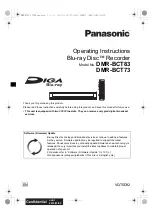
DS-D98 recorder
TASCAM DS-D98 -
11
In addition to these controls and indicators, the fol-
lowing settings are transmitted “down the chain”
from the master to the slave branch units (for these
settings, the appropriately-labeled master branch unit
key controls the status of the slaves):
• ALL SAFE condition (6.3, “Recording the first
tracks”)
• ALL INPUT condition (5.1.1, “ALL INPUT and
INPUT MONITOR”)
• AUTO MON condition (5.1.2, “AUTO MON”)
The end result of this arrangement is that the DS-
D98, when acting as a master in this way, can appear
to be a multi-track recorder. With three branch slaves
connected, a single unit can control a full eight tracks
of DSD recording.
NOTE
Strictly speaking, the branch slave units do not need to
be in 2-track mode, but only the first two tracks of a
slave unit are accessible from a master when they are
connected in this way.
Branches and chains
Since sixteen machine IDs are available, the maxi-
mum number of units which can be branched in the
way described above is sixteen (one master branch
unit and up to fifteen branch slaves).
However, it is also possible to use the standard DTRS
chaining method, so that one remote controller such
as the RC-898 can control a chain of DTRS nodes. If
these node devices are DS-D98 units, each one of
these chain node slaves can act as a branch master of
up to fifteen branch slaves (a total of up to 256
machines).
As far as the ID of the master node of each branch is
concerned, this must follow the conventions of the
node chain (in other words, the IDs of the branch
master units — that is, the nodes in the chain — must
go in sequence from 1, starting with the machine
closest to the remote control unit).
The first slave branch units in the branches must be
numbered with ID 2, and the others must follow in
sequence.
Since there are two ways of connecting: the node
chain and the branch, it is therefore possible to have
the same machine ID occurring twice in a branch
(once for the branch master, and once for one branch
slave). It is not possible to have the same ID occur-
ring twice in a node chain, however.
Specifications
Audio characteristics
These figures are measured with the I/O Clock Range
set to Narrow (see 6.1.3, “Clock range with slot
board” in the main manual:
Analog performance
Frequency response:
10Hz to 20kHz ±0.5dB
10Hz to 50kHz –3dB (±1dB)
Distortion:
0.005% (1kHz, AES-17 filter)
S/N ratio:
> 102dB (1kHz, AES-17 filter and A-weighting)
Dynamic range:
> 102dB (1kHz, AES-17 filter and A-weighting)
Channel separation:
> 95dB (1kHz)
Input connectors
XLR-3-31 type (x 2)
Nominal input level
+4dBu
Reference level
–16dBFS
a
, –18dBFS, –20dBFS
Maximum input level:
+20dBu
a
, +22dBu, +24dBu (jumper-selectable)
Input impedance:
> 15k
Ω
Output connectors
XLR-3-32 type (x 2)
Nominal output level
+4dBu
Reference level
–16dBFS
a
, –18dBFS, –20dBFS






























